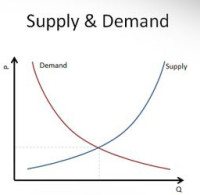In our continuing Revenue Management series, RoomKeyPMS partner iRates explains why following your competitors’ price is not an ideal pricing strategy.
Another misconception that is still prevalent among hotels of all sizes and star ratings is that in order to be priced accurately, one needs to follow their competitors’ rates. Unfortunately, this point of view is also shared by large hotel management companies, hotel chains and even some Revenue Management companies. This is a habit that has been very heavily ingrained in the Hospitality industry, and breaking this norm is going to take a lot of reinforcement.
The general logic behind this point of view is normally the following: the prices that your neighbors are charging for their hotel rooms comprise the supply and affect the market conditions. Overall, there’s nothing wrong with this statement. Definitely, for the correct understanding of the hotel’s position in the market, it’s important to be aware of the rates that your competitors are charging for any given day in the future. However, in many cases, following their prices blindly draws you away from the optimal market price (based on real supply and demand), and actually makes your hotel lose money.
How do hotels take into account competitors’ prices? There are a few ways (none of which are optimal):
- Some hotels pick one competitor that they consider “the closest” and come up with a “magic differential” (“I need to be $20 below the Best Western next door”), and think that they’ve implemented a sophisticated Revenue Management technique.
- Others, more advanced, calculate an average of all the compset prices and follow that. This method is widely used in Revenue Management modules built into some Property Management Systems.
- Another method is using compset prices to set parameters (the floor and the ceiling) for the hotel’s daily rate that is calculated some other way.
None of these methods works. Or rather, they work to some extent but this behavior is far from optimal, and in many cases leads to revenue losses. Let’s examine why.
If we want to take the competitors’ rates into account directly and base our pricing recommendations on this information, then:
- We have to assume that the hotel selected a proper compset.
How often does this happen? How do you evaluate whether this particular competitor is indeed in your direct market? Or do you just look at the list in your STR report?
- Even if the above is correct, we have to accept another assumption: the competitors actually know what they’re doing (i.e. they’re properly following demand fluctuations and are instantly reacting to these fluctuations with accurate and optimal pricing).
Can you say that about each hotel in your compset? Your competitors are not always skilled in current Revenue Management strategies, and don’t always adequately react to the changes in demand, especially if they’re not using an automated Revenue Management solution. Then why should we be following them? Why not be smarter? If our demand is strong and it dictates to raise the price up to $200, while everybody else is charging $150 – would we not do that? Why do we want to limit ourselves by the decision of somebody who is not aware of the true demand? Do you want to end up in a situation where “the blind are leading the blind”?
- Your competitor may have just booked a large group reservation that leads to an increase in price for transient business.
Group business obviously cannot be considered as part of the transient demand. Your neighboring hotel just became “twice as small” after booking the group. They have less rooms to fill and thus can afford to increase their price. Why would you increase yours if your demand hasn’t changed, and you don’t have the same group on the books?
- Did you know that your true compset constantly changes? It is not the same every day. This may depend on the day of the week or a particular event.
Numerous OTA websites make the travel market transparent. Now customers are equipped with a wide range of tools that help them navigate the market of hotel rooms knowing much more about every hotel available online. And this information significantly adjusts their view on what properties to consider during their search.
Customers booking during the week may be selecting among one set of hotels in the area that are closer to the Convention Center, weekend travelers are looking at properties closer to the beach. You’re on the edge of both markets – your hotel is considered in both cases. How do you handle this scenario?
- Did you know that even for the very same day, different market segments are considering a different set of hotels?
On a Thursday, some guests are booking to attend a corporate event (they are looking at hotels with meeting space), some want to start their weekend early and look at properties near the entertainment district. Your hotel is in the middle of it all and has a 1000 sq. ft. meeting room. Who do you consider your compset on that Thursday?
All the points above explain why you’ve noticed situations (if you’re attentive enough) when your demand doesn’t change even though the Best Western next door changed their price by $20. This may have happened for any of the following reasons:
- This is not really your true competitor
- Their pricing decision was not based on real demand conditions
- They may have just booked (or cancelled) a large group
- Your hotel is in a more (or less) advantageous position on this particular day
- Your hotel is in a more (or less) advantageous position for a particular market segment that is booking your hotel at the moment
The demand (your demand) doesn’t go down but you lower your price out of habit, losing money at the end by artificially lowering your ADR. Or, vice versa, you increase your price, which kicks you out of the competition, and you lose customers. In both cases, you end up leaving money on the table.
So what do you do? How do you take all of this into account? The answer is: don’t lose your mind over the compset. Instead, what you should do, and what will help your hotel’s revenue grow faster than your competitors’, is recognize the real demand flow that is coming into your particular hotel and efficiently react to the changes in this demand by adjusting your prices accordingly.
The best way to do it is to adopt an automated Revenue Management solution. If you don’t have an automated RM solution, then assess real market conditions and follow your demand fluctuations by accurately evaluating your booking pace (pickup dynamics). Unfortunately, most Property Management Systems are built in a way that does not allow for the tracking of booking pace, so managers have to manually accumulate daily pickup data. You can have a spreadsheet running, which would look like this:
Why is pickup (when you don’t have any other tools on hand) a much better indicator of the demand strength than your neighbor’s prices? Let’s imagine a situation when a manager is reviewing the upcoming weekend in order to make a pricing decision. Occupancy is at 70%. The hotel next door has been charging $139, you’re at $149.
Scenario 1: during the last 7 days occupancy for the weekend has been picking up at a steady pace, about 5% a day, with a jump of 10% since yesterday.
Scenario 2: no reservations have been booked for the weekend during the last 7 days, and the hotel received 3 cancellations yesterday, thus the occupancy dropped from 73% to 70%.
We can see that in the 2 cases above, with occupancy, the number of remaining days and the competitor’s price being equal, the Revenue Management decisions should be opposite. Scenario 1 describes high demand with strong pick up (regardless of the fact that your hotel is charging a premium price, which may be justified by some amenities that your hotel is offering or proximity to an attraction, etc.) which allows for a price increase since the pickup indicates early sell out at the current price. Scenario 2 describes a situation when either the demand is very weak or the hotel’s room rate is too high. Thus the most logical decision, in this case, would be to lower the rate to stay competitive.
Everything stated above does not eliminate the need to be aware of the competitors’ prices in order to have a clear understanding of what is happening in the market, and how your property is positioned in it.
There are a few ways to obtain compset rate data:
- Manual methods:call-around (front desk agents calling other hotels in the area hoping to receive an honest answer), or manually checking for hotels’ rates on OTA websites and meta sites.
- Automated methods (monthly subscription):Travelclick (Rubicon reports), Revcaster, RateGain, eRevMax, etc.
- In addition, many Revenue Management Systems have rate shopping components built into their interface for easy access to this data.
The best advice would be: don’t wait – automate!
Today, thanks to the great achievements in computer technology and computer networks, affordable automated Revenue Management has become available for low- and middle-tier hotels, small hotel chains and independent properties.
To conclude this conversation, instead of blindly following your competitors’ rates, in order to be effective in your Revenue Management strategies, you as a manager, should recognize the true demand flowing into the hotel and efficiently react to the changes in this demand. Whatever the factors affecting demand are (compset rates, weather, gas prices, etc.) they will all be reflected in the demand fluctuations.
Ira Vouk, CRME
iRates, LLC.
www.i-rates.com








